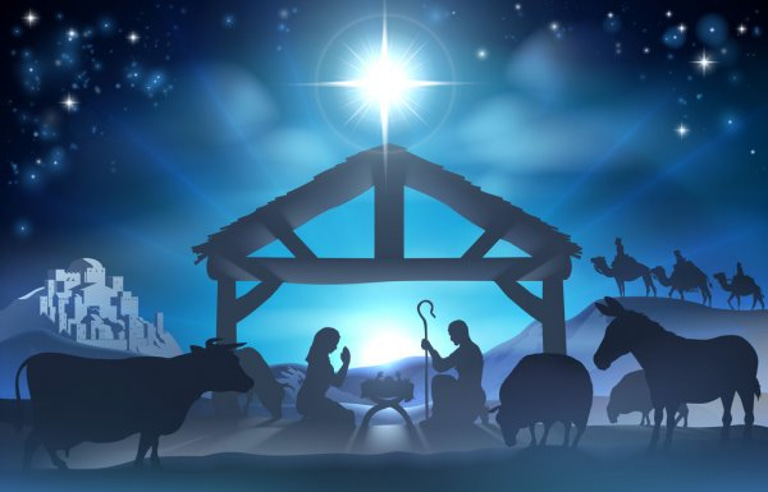Perfecting Your Nativity Scene: Common Figure Setups
Wonder how to set up your Nativity scene? Explore popular opinions and tips that make your display shine. Get started today!
NATIVITY SETUPS
Grace Callahan
5/8/202412 min read
What are the essential figures in a Nativity scene and how should they be arranged?
The central figures are the Holy Family: baby Jesus in the manger, flanked by Mary and Joseph. Mary is typically placed closer to Jesus, with Joseph on the opposite side. Shepherds with their sheep are positioned nearby, symbolizing humble witnesses, while the Three Wise Men are often set at a distance, representing their journey from afar. An angel is usually placed above or near the stable, signifying the divine announcement of Jesus' birth.
What is the significance of the animals included in the Nativity scene?
Animals like the ox and donkey are traditional additions, symbolizing patience and humility. Sheep, accompanying the shepherds, represent innocence and peace. Camels are associated with the Wise Men, indicating their long journey. These animals enhance the pastoral and humble setting of Jesus' birth.
How can I personalize my Nativity scene to reflect my family's traditions?
Personal touches can include adding family heirlooms, handcrafted figures, or elements reflecting your cultural heritage. Involving family members in setting up the scene, incorporating seasonal scents, or gradually adding figures throughout Advent can make the display more meaningful and reflective of your family's unique traditions.
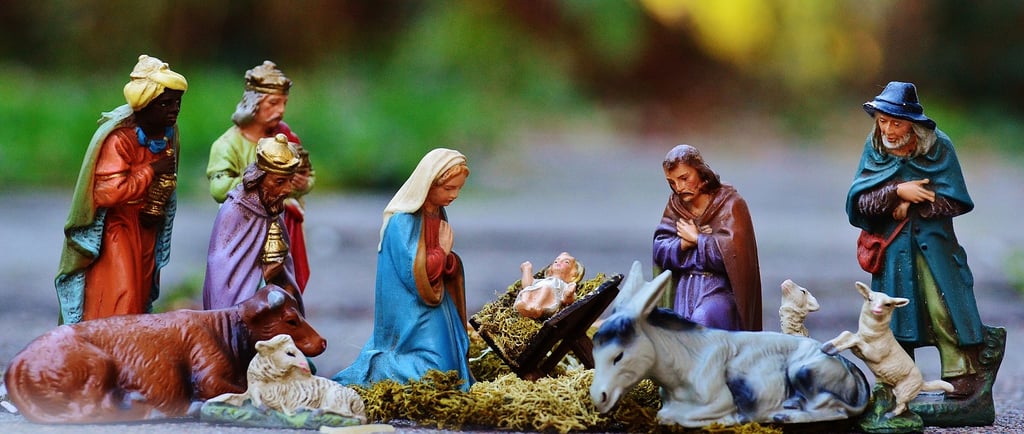

Introduction
The Christmas season is upon us, and with it comes the time-honored tradition of setting up Nativity scenes. These beautiful displays are a cherished way to celebrate the birth of Jesus, and they bring a sense of warmth and reverence to our homes. But have you ever wondered about the most common figure arrangements for the Nativity? Let's explore the key elements that make up these enchanting displays and how you can arrange them to create a captivating scene that tells the timeless story of the Nativity.
The Holy Family: The Heart of Every Nativity Scene
At the very center of every Nativity scene lies the Holy Family: Mary, Joseph, and the baby Jesus. This sacred trio is the heart of the Christmas story, embodying themes of love, faith, and humility. Each figure is thoughtfully designed to tell their part of this timeless narrative.
Mary is usually depicted as a young mother, radiating serenity and devotion. She is often shown kneeling or sitting close to the manger, her hands gently folded in prayer or extended in an expression of awe and love for her newborn son. Her attire typically features soft, flowing fabrics in shades of blue and white, symbolizing purity and peace.
Joseph, the earthly father of Jesus, is a figure of quiet strength and steadfastness. Often standing protectively beside Mary and the manger, Joseph is portrayed as a caring guardian. His posture might show a gentle humility, leaning slightly toward his family. You’ll often find him dressed in earth tones, reflecting his role as a humble carpenter.
Baby Jesus is the centerpiece, cradled in a simple manger filled with straw. Swaddled in modest cloth, His presence represents divine light and hope. In some Nativity sets, the baby is shown with outstretched arms, a tender invitation to all who witness the scene. The manger itself is a symbol of humility, a reminder that greatness can come from the humblest of beginnings.
Together, the Holy Family captures the essence of the Christmas story, radiating love and simplicity. This central tableau serves as a profound reminder of the miracle of the Nativity, inviting reflection and reverence for the season.
The Angel: A Celestial Messenger
An angel often graces a Nativity scene, standing or hovering close to the Holy Family. This heavenly figure symbolizes the divine announcement of Jesus’ birth, as described in the Gospel of Luke, when the angel proclaimed the good news to shepherds watching their flocks by night.
The angel is typically depicted with grand, outstretched wings that emphasize their celestial origin. Often adorned in flowing robes of white or gold, they bring a sense of ethereal beauty to the display. In many scenes, the angel holds a banner with the words “Gloria” or “Glory to God in the highest,” echoing the heavenly message of peace and goodwill to all.
Positioning the angel varies by tradition and creativity. Some Nativity sets place the angel hovering above the stable, as if descending from the heavens, while others position them standing nearby, watching over the Holy Family. Their radiant presence adds a sense of divine wonder, reminding viewers of the miraculous and joyous nature of Jesus’ birth.
The angel not only enhances the visual beauty of the Nativity but also connects the earthly scene to its heavenly significance. It invites reflection on the joy and hope heralded by that first Christmas night, making it a cherished and meaningful part of the display.
The Shepherds: Humble Witnesses to the Miracle
Shepherds hold a special place in the Nativity scene, symbolizing humility and faith. These simple caretakers of sheep were among the first to hear the angel’s announcement and to witness the miracle of Jesus’ birth, as recorded in the Gospel of Luke. Their inclusion in the Nativity reminds us that the good news of Christ’s arrival was meant for all, regardless of status or wealth.
In a traditional Nativity display, shepherds are often shown in rustic attire, wearing robes and cloaks suited to their life in the fields. They may carry a staff or sling a pouch over their shoulder, highlighting their modest lifestyle. Their expressions and postures often convey awe, joy, or reverence, emphasizing their heartfelt response to the angelic message.
Accompanying the shepherds are their faithful sheep, which add a pastoral charm to the scene. These gentle animals, depicted lying or standing near their caretakers, symbolize peace and innocence, enhancing the tranquil atmosphere of the Nativity.
Shepherds are typically placed around the Holy Family, some kneeling in adoration, others standing in wonder. Their presence brings an earthy, relatable element to the display, bridging the divine story with the everyday lives of ordinary people. By including the shepherds, the Nativity scene beautifully captures the inclusive message of Christmas—that grace and hope are gifts for everyone.
The Three Wise Men: Regal Visitors from Afar
The Three Wise Men, or Magi, bring a sense of grandeur and mystery to the Nativity scene. These noble figures, often described as kings or learned astrologers, journeyed from distant lands, guided by a brilliant star, to honor the newborn King with their precious gifts. Their inclusion reminds us of the universal reach of Jesus’ birth and its significance for all nations and cultures.
Typically, the Wise Men are depicted in resplendent attire, adorned in vibrant, richly detailed robes and crowns or turbans that reflect their status and the exotic regions they hail from. Each figure carries a gift—gold, symbolizing Jesus' kingship; frankincense, representing His divinity; and myrrh, foreshadowing His sacrificial death. These offerings hold profound spiritual meaning, enriching the symbolism of the Nativity.
In many displays, the Wise Men are placed at different distances from the Holy Family, representing the stages of their journey. This creative positioning can highlight the anticipation and dedication of their pilgrimage. In other arrangements, they are shown kneeling or bowing before the manger, presenting their gifts in a gesture of deep reverence and homage.
The Three Wise Men add an element of majesty and global perspective to the Nativity scene. Their presence celebrates the recognition of Jesus as King and Savior, not only by the humble and faithful but also by the wise and noble, underscoring the inclusivity and far-reaching impact of the Christmas story.
The Animals: Gentle Companions in the Nativity Scene
Animals bring warmth and charm to the Nativity scene, reflecting the humble and natural setting of Jesus’ birth. Their presence reminds us of the simplicity of the stable and the quiet wonder of that sacred night.
The ox and the donkey are among the most traditional figures, often placed near the manger to symbolize patience, service, and the peaceful atmosphere of the stable. Their inclusion has roots in Christian tradition and prophecy, evoking imagery from the Old Testament that speaks of animals recognizing their Creator.
Sheep accompany the shepherds, adding a pastoral touch that reinforces the humble nature of the first visitors to the newborn King. These gentle creatures symbolize innocence and peace, further enhancing the serene setting of the Nativity.
Camels, associated with the Wise Men, often make an appearance, lending an exotic and majestic element to the scene. Their inclusion reflects the long journey undertaken by the Magi to honor Jesus, emphasizing the far-reaching significance of His birth.
Each animal adds its own unique texture and meaning to the Nativity, whether through their symbolic roles or their simple, earthly presence. Together, they help create a vivid and relatable depiction of the humble surroundings of the Holy Family, drawing us into the story with a sense of awe and tenderness.
Additional Figures and Elements: Bringing the Nativity Scene to Life
Adding extra figures and elements to your Nativity scene can transform it from a simple display into a bustling, vibrant tableau full of life and storytelling. These additions enhance the scene's charm, providing context, depth, and a sense of community around the Holy Family.
Additional Characters
Village Folk: Include villagers going about their daily lives—carrying baskets, fetching water, or tending animals. These figures add a sense of normalcy and connect the extraordinary birth to everyday life. Position them near the edges of the scene to create a feeling of a larger world extending beyond the stable.
Musicians: A drummer, a flute player, or a lyre musician can evoke the joy of celebration. Place them near the shepherds or villagers to depict spontaneous rejoicing at the news of Jesus’ birth.
Children: Figures of children bring innocence and playfulness. They can be shown watching the Holy Family in awe or interacting with animals to create a warm, relatable touch.
Animals and Nature
Expanded Animal Cast: Beyond the traditional ox, donkey, sheep, and camels, consider adding chickens, dogs, or birds. These small additions add detail and make the scene feel more lived-in.
Natural Elements: Incorporate moss, straw, pebbles, or small plants to mimic the landscape of Bethlehem. Create pathways with sand or gravel leading to the stable to guide the figures.
Structures and Props
Stable: The stable is the centerpiece that houses the Holy Family. Choose or build one with rustic wooden beams, thatched roofs, or stonework for a historical touch.
A Well or Fountain: Place a small well or fountain near the villagers to suggest the necessities of life. This also creates a natural gathering point.
Market Stalls: Miniature market stalls with baskets of fruit, bread, or pottery can add vibrancy, reflecting the daily life of the time.
Campfire or Lanterns: Include a tiny campfire near the shepherds or lanterns around the stable to create a warm, inviting glow.
Heavenly Touches
The Star of Bethlehem: A radiant star placed above the stable is an essential symbol. Use a glowing or illuminated star to draw the viewer’s eyes to the Holy Family.
Additional Angels: Include smaller angels in the background or among the villagers, emphasizing the divine presence.
Creative Display Ideas
Layered Scene: Use different levels to separate the stable, shepherds, Wise Men, and villagers. Books or risers covered with natural fabric or moss can create hills or terraces.
Panoramic Display: Extend the scene with additional buildings like small houses, inns, or a cityscape in the distance, suggesting Bethlehem’s bustling environment.
Interactive Details: Add movable figures or elements like a spinning star or flickering lanterns to bring a dynamic feel to your display.
By weaving these additional figures and elements into your Nativity scene, you create a richer, more immersive story. It invites viewers to step into the world of Bethlehem, experiencing the wonder and joy of the first Christmas in a deeper way.
Arranging Your Nativity Scene: Tips for a Beautiful Display
Arranging your Nativity scene is a delightful opportunity to tell the Christmas story in your own way. While there’s no single “right” method, following these tips can help you create a harmonious and meaningful display:
1. Focus on the Holy Family
Central Placement: The Holy Family—Mary, Joseph, and baby Jesus—should be the heart of your Nativity. Place them at the center of your scene, ensuring they’re the main focal point.
Highlighting Baby Jesus: Position the manger slightly forward and ensure it’s well-lit to draw attention. Mary and Joseph can be arranged on either side, gazing lovingly at their child.
2. Consider the Angel’s Placement
Overseeing the Scene: Place the angel above or near the stable, symbolizing its divine proclamation and watchful presence.
Announcing to the Shepherds: Position the angel facing the shepherds, as though delivering the heavenly message.
3. Group the Shepherds and Animals
Pastoral Scene: Arrange the shepherds and their sheep together, ideally to one side of the Holy Family. Include some sheep lying near the manger to emphasize their connection to the story.
Natural Flow: Position the animals so they seem to interact naturally with the shepherds and surroundings, creating a cohesive vignette.
4. Highlight the Journey of the Wise Men
Symbolizing the Journey: If you have ample space, start the Wise Men at varying distances from the stable. This visually narrates their long pilgrimage.
Close to the Holy Family: Alternatively, place the Wise Men near the manger, presenting their gifts. Arrange them in a semi-circle to keep the focus on their act of reverence.
5. Add Depth with Additional Elements
Layering and Height: Use risers, small boxes, or natural materials like rocks and moss to create varying heights. Place taller elements (like the angel or a backdrop) at the back and smaller figures in the foreground for depth.
Structures and Accessories: Add a stable, well, or small props like baskets and lanterns to enrich the scene. Position these elements to frame or complement the main figures.
6. Play with Lighting
Soft Illumination: Use warm lights or candles to highlight the Holy Family and other key figures. Fairy lights or an LED star can add a magical glow to the display.
Shadow and Contrast: Place subtle lighting behind figures or structures to create a sense of dimension and atmosphere.
7. Consider the Overall Balance
Asymmetry for Interest: While balance is important, an asymmetrical arrangement often feels more natural and dynamic.
Spacing and Flow: Avoid overcrowding; leave enough space between figures to maintain clarity and focus.
By combining these tips with your personal creativity, your Nativity scene will not only be visually stunning but also a heartfelt representation of the Christmas story.
Creating a Personalized Nativity Scene: Ideas for a Meaningful Display
Setting up a Nativity scene is more than just decorating—it’s a chance to express your family’s traditions, creativity, and faith. Here are some thoughtful ways to make your Nativity scene uniquely yours:
1. Incorporate Family Heirlooms
Cherished Keepsakes: If you’ve inherited figures, a stable, or other accessories, include them in your display. Even if they don’t match the rest of your set, they bring a sense of history and sentimentality.
Blend Old and New: Combine heirlooms with modern additions to symbolize the continuity of your family’s Christmas celebrations through generations.
2. Add Handmade Touches
Crafted Figures: Create your own figures using clay, wood, or fabric. Crocheted animals or painted figurines can add a whimsical and heartfelt element.
Custom Structures: Build a stable, well, or backdrop from natural materials like wood, bark, or twigs. Personalize these with your favorite colors or embellishments.
Seasonal Scents: Enhance your scene with natural elements like cinnamon sticks, pinecones, or dried orange slices to evoke the scents of the season.
3. Reflect Your Cultural Heritage
Cultural Figures: Incorporate figures or costumes that reflect your family’s cultural traditions, such as a Wise Man in regional attire or a villager carrying culturally specific items like food or pottery.
Decorative Details: Add ornaments, patterns, or colors inspired by your heritage to the scene, weaving your family’s story into the Nativity.
4. Make It Interactive
Family Participation: Invite everyone, especially children, to help set up the scene. Let them decide where to place figures and share the story behind each one.
Storytelling Opportunities: Use the setup process to narrate the Nativity story, discussing the roles of each figure and their significance.
Advent Tradition: Incorporate movement by gradually adding figures to the scene throughout Advent, culminating with placing baby Jesus in the manger on Christmas Day.
5. Change It Up Every Year
New Additions: Add a new figure or accessory each year to symbolize growth in your family’s traditions. This could be an animal, a villager, or even a unique cultural element.
Themed Arrangements: Try different themes—rustic, modern, or nature-inspired—to give your scene a fresh look while keeping its essence intact.
Different Perspectives: Experiment with the arrangement, such as placing the Wise Men on a distant “journey” or using a creative backdrop like a winter village or starry night.
6. Capture the Spirit of Your Family
Personal Tokens: Include small items that hold special meaning for your family, such as a tiny photo frame, a favorite ornament, or a handwritten note tucked into the scene.
Memory Display: Document each year’s Nativity scene with photos or notes about the changes and additions, creating a journal of your family’s evolving tradition.
By infusing your Nativity scene with personal touches, you create more than a decoration—you create a heartfelt tradition that reflects your family’s love, faith, and creativity, making the Christmas season even more special.
Conclusion
Setting up a Nativity scene is a cherished Christmas tradition that brings the story of Jesus' birth to life. By understanding the most common figure arrangements and adding your own personal touches, you can create a beautiful and meaningful display that captures the essence of the season. Whether your Nativity scene is simple or elaborate, it's a wonderful way to celebrate the true meaning of Christmas and share it with loved ones. So gather your figures, arrange them with care, and let the story of the Nativity unfold in your home this festive season.
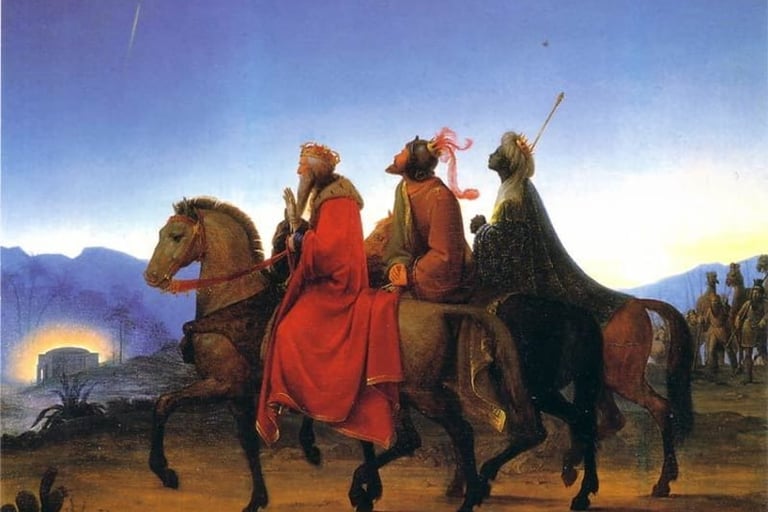

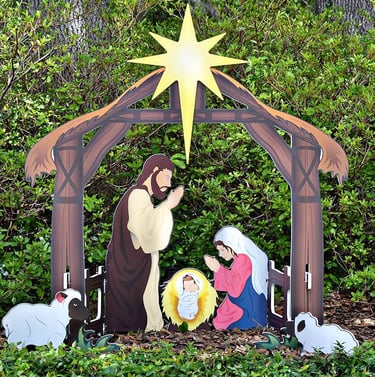

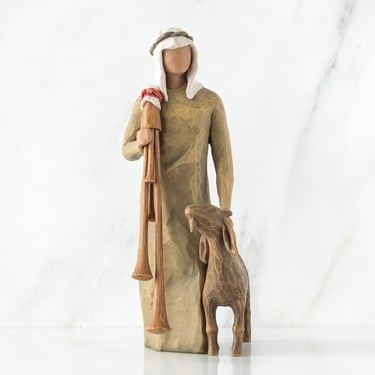

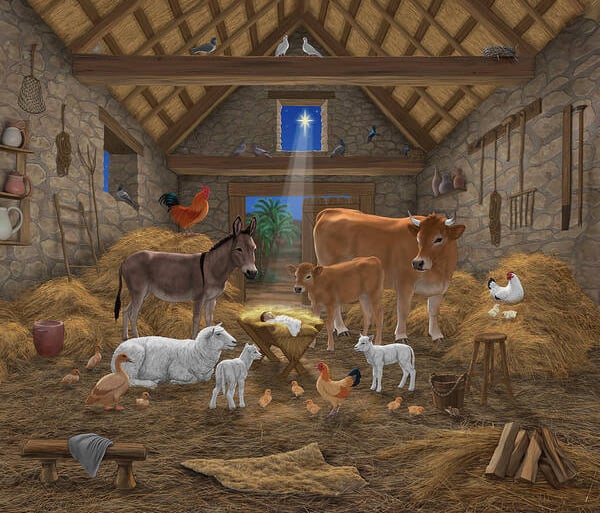

Please see my related posts
The Role of Animals in Nativity: Faith and Tradition
Artistic Roots of Elephant Imagery in the Nativity Scene
The Star of Bethlehem: A Beacon of Hope in the Nativity
How the First Nativity Scene Came to Life: A Rich History
Faith and Humility: Joseph's Key Contribution to the Nativity
The 3 Wise Men’s Journey: Their Mode of Travel Revealed
The Star of Bethlehem: A Heavenly Mystery Explained
